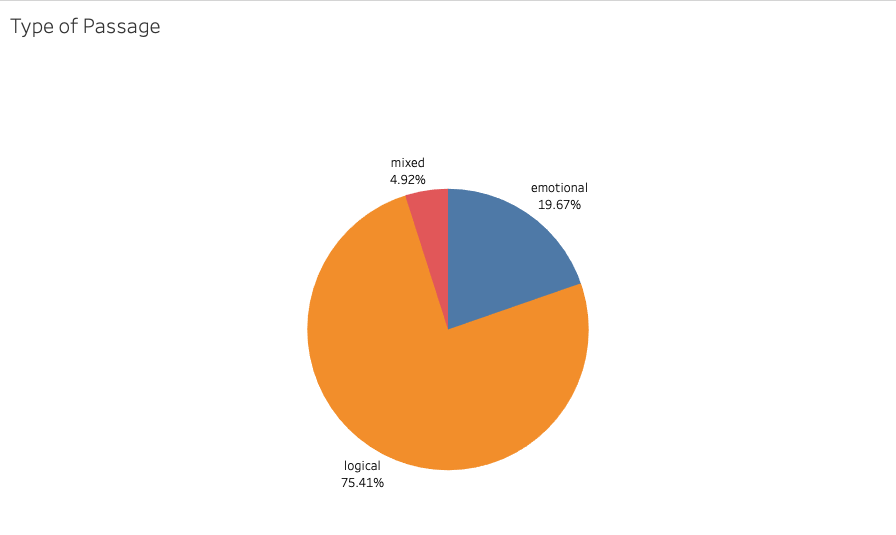Text analysis is particularly interesting to look at if we want to discover patterns involving specific words. But to get a better idea of the statistics involving the overall corpus, I used Tableau to help me graph out trends.
Subject

After separating the same corpus I used for the text analysis into 63 different passages, I grouped each passage by category according to the following qualifications:
- Clean up: subject matter dealing with providing relief for neighboring communities or restoring the campus to its original state.
- Damage: passages describing the state of campus/nearby towns after the hurricane, or effects that the hurricane had
- Destruction: descriptions of events occurring during the process of the hurricane
- Displacement: passages dealing with the evictions of victims
- Humor: passages intended to produce a comedic effect
- Restoration: documentation of the process of repairing damaged infrastructure/landscape back to its original state
- Spirit: excerpts describing the sense of community that arose out of the students’ and faculty’s common goal of restoring the campus, as well as the importance of looking towards the positive during times of disaster
- Other: miscellaneous passages that did not fit into any of the previous categories
Significant coverage is given to the damage that the hurricane has caused, on both the college campus and in neighboring towns (37.70%). Surprisingly, the Amherst Student also manages to include a few passages that poke fun at the way some Amherst students reacted to the hurricane. For example:
“The story of John F. (Ace) Hall is one of innocent peace and un-requiting quiet. Completely fagged by the strenuous rushing season of Phi Psi, Hall retired to his bed early Wednesday afternoon. Came the hurricane, the crashing trees, the moaning wind and the pounding rain: through all of which slept the tired warrior, undisturbed. Eventually Hall awoke, after the storm had lulled, and when approached by the brethren concerning the trifling matter of a hurricane, he remarked, “Hurricane? Yeah, and my name is Cleopatra.”
Location
In addition, I also graphed the frequency of locations mentioned both off- and on-campus:


The graph above again shows the importance of Johnson Chapel during the time of the disaster. Pratt, which had been a gymnasium in 1938, served as a relief center where refuges could find food and shelter.
Logic vs. Emotion

Finally, I analyzed the corpus by assigning either “logical,” “emotional,” or “mixed” to each passage depending on whether the passage appealed to logic, emotion, or both. Here are some of the criteria I used to determine what category each belonged to:
Logical passages tended to have the following characteristics:
- focused on factual events/happenings/stats
- intent was to inform readers
- used straightforward, easy to comprehend language
“The college has brought in nationwide tree experts to advise on the pruning of damaged trees and the landscaping of the campus. One crew of climbers is coming up from West Virginia to clean up the trees that were left standing.”
Whereas emotional passages often displayed these features:
- increased use of adjectives
- tended to focus on personal narratives
“With a Tom Sawyerish lust for adventure and a paradoxical aversion for nights spent in Northampton, he grimly gripped the sagging rail and edged his way precariously back to safety, several times slipping and becoming half immersed in the raging torrent.”
The passages that fell into the “mixed” category either fulfilled criteria for both categories above, or did not fall cleanly into either category.
Concluding Notes
I think it is interesting to note that a large majority of the passages were deemed to be “logical.” For a disaster of such large scale, one might have expected a student newspaper to cover more about the students’ emotional responses to the event, or their thoughts on administrative policies/decisions that were made during the time. However, we do not see any such passages and even the passages that fell into the “emotional” category were more so about students working together towards a common goal in light of the catastrophe. They mainly focused on the spirit and camaraderie that brought Amherst together.
Based on publications in recent years, the Amherst Student seems act much more as a channel for student voice now. It seems that there are many more opinion-type pieces, and more emphasis is placed on expressing student sentiment on various changes within the institution. Student quotes are a staple, and they are not afraid to express how they truly feel about campus issues.
In the time of this pandemic, the Amherst Student has made a conscious effort to highlighting student responses and experiences related to the numerous changes in policy the College has made. Much attention has been brought to various concerns and dissatisfaction, with just a few examples below:
Students and Faculty Set Out to Make Sense of Recent COVID-19 Changes
Two Weeks In, Amherst Community Reflects on Remote Learning Adaptations
I will conclude with a question: which style allows for more “accurate” news and reporting of history? The 1938 style features less emotion and more logic, which is usually associated with precision and truthfulness. But at the same time, student response and opinion is an important part of history that deserves to be recorded too. As a (newbie) archivist, I can’t help but think about all the information we would lose if “human” side of history is lost. How do we as humans respond to disasters? What complex emotions follow these extreme and sudden changes? Was the administration’s course of action the best response? These are all emotions and opinions that deserve to be recorded, too.
These insights can provide valuable information that can be used as lessons for future. Backlash or agreement can guide future decisions and provide guidelines for what changes need to be made.
None of this would be complete without the humanization of history.
Navigation:
Overview | Text Analysis | Trends

You must be logged in to post a comment.